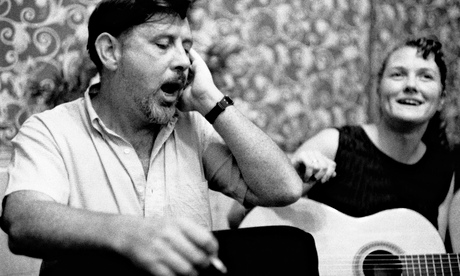
"It's a vernacular spectacular!", screams Jarvis Cocker from the cover of this celebration of British folk clubs, as the Pulp frontman, DJ and now editor-at-large at Faber really should. Cocker's appointment in 2011 rubber-stamped the publisher's interest in big music titles. And when I say big, I mean big. In recent years, Bob Stanley's history of pop, Dorian Lynskey's catalogue of protest songs and Richard King's overview of indie have all been gargantuan paperbacks. For a subject as undervalued as folk music, a similarly meaty exploration is long overdue.
Nevertheless, JP Bean's book feels cut from a different cloth than its Faber siblings. Singing from the Floor is an oral history, for starters, not a conventional author-led tour. A chorus of famous and not-so-famous voices take us through the rise of the scene, from seedy London dive sessions and library sing-arounds to the post-skiffle explosion of clubs in the early 60s, via the arrival of nosy parkers such as Bob Dylan and Paul Simon to the legacy of that scene today. We encounter linchpins such as Martin Carthy, June Tabor and Wizz Jones, and others who went on to achieve fame elsewhere (Billy Connolly, Barbara Dickson).
In principle, this cacophony of voices is a perfect narrative device – the sharing of stories in a communal way is what usually happens in a folk club, after all. In practice, they overlap and repeat things, slowing down the text, lessening the lightning-bolt impact of folk music on pop and politics.
What's needed is a stronger curator and shaper of this material throughout. A Sheffield writer with a background in non-fiction, radio plays and documentaries, Bean shows ample enthusiasm for this project in his preface, laying out the utopian ideas behind it. "Any comment from myself [on my interviewees] would be superfluous," he says, then apologises for having "to edit and compress some material". The spirit of editing isn't anathema to folk – singers often alter songs to harness their power. Folk songs are also about passion, jealousy, murder, rape, horror and death. More drama in Bean's narrative, therefore, wouldn't have been sacrilege.
Interviewees aren't sufficiently pressed either. A chapter about Ewan MacColl's disruptive personality begins well enough, especially as his take on folk music was so scholarly and draconian: at one point he tells off Shirley Collins for having "the temerity to paint my fingernails pink" (more of this Sussex singer's barbed frankness would have benefited the book). It's also a shame we don't hear more from MacColl's American widow, Peggy Seeger – the beginnings of their relationship and the subsequent impact they had on the folk scene is quite the tale (she became pregnant by him at the same time as his wife was – that's a folk song right there).
The chapter about Dylan's arrival in London is better, as the schisms between the old guard and the new simmer and seethe. The image of him jiggling on a loo, high on pot, talking to Scottish rebel singer Jim McLean, is particularly lovely. There are other great anecdotes, such as Norma Waterson's memory of blues star Big Bill Broonzy wanting "whisky and chips" in a fish restaurant in Hull, or Tyneside singer Bob Davenport being invited to a folk club to teach the crowd "how not to sing". Wonderfully, he says: "I just gave 'em two fingers."
Bean brings us up to the present day with a warm whip around contemporary musicians, but a spirit of reverence reigns here, rather than the rough-and-ready honesty the subject deserves. Often, Singing from the Floor plods, showing that size isn't everything. That's not to say that folk fans won't find some interest or sustenance in this weighty book, but the right words do have to be chosen, and chosen well, to make a story really sing.

